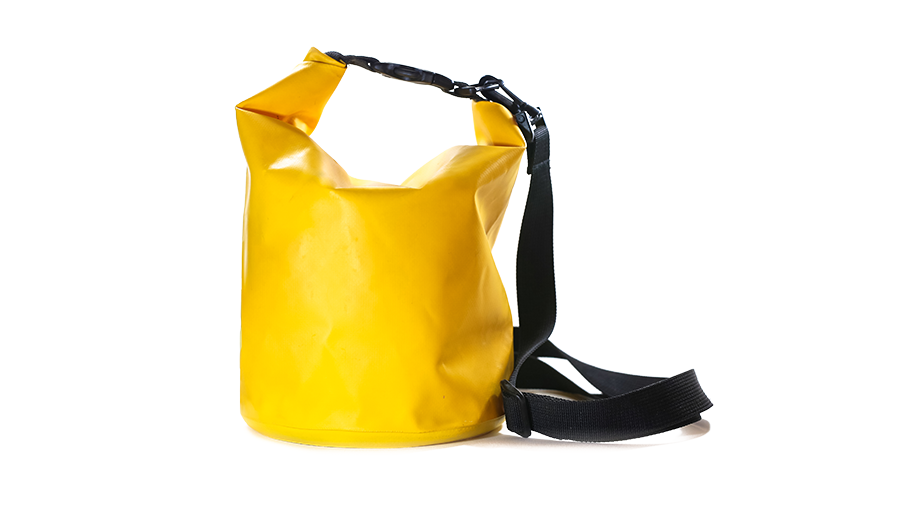The Grab Bag for Cruising Sailors
Surrendering a ship should be the last option in a sea emergency. If, however, the crew has no choice but to go to the life raft, the essentials should be ready to hand. The Pantaenius experts have compiled the definitive Grab Bag.
The on board life raft is one of the things one hopes will never be used. "Anyone who has ever completed offshore safety training, knows to fight for their ship until the very last moment before taking to the life raft," confirms Kim Reise, experienced touring sailor and Pantaenius yacht insurance specialist in the field of yacht damage. “A floating ship will always offer greater safety and more stability than a life raft, so the life raft is the last resort before the ship sinks.”

However, there are situations where the yacht has to be abandoned - Reise has one or two customers every year who are forced to use their life raft. "Often, in the hustle and bustle and at night, vital things are forgotten on board when leaping to the life raft. For example, a customer forgot his diabetes medication and had to climb back into the sinking ship - an unnecessary risk at an already critical moment.”
A "grab bag" is a bag in which everything necessary for survival on a life raft is stowed and which is ready to grab at any time with an easily accessible handle. There are special pre-packed bags on the market, but practically any waterproof, floating and hardwearing container is suitable for use as a grab bag. A waterproof bag, for example, is a good choice and make sure it contains about 30 per cent air. Canisters with large lids are also practical.
What belongs in the grab bag?
According to the ISO 9650-1/2 standard, which has been in force since 2005, a life raft must have a certain minimum configuration. These include a drift anchor, a knife, a leak plug, a torch, two paddles and a casting ring. Not every owner knows how his life raft is equipped - use the next maintenance interval to inspect the equipment. The Grab Bag is mainly for personal effects, communication and safety:
1) Waterproof handheld radio
In order to radio Mayday and communicate with the rescue services, a good handheld radio is essential. Ideally, it should be DSC-enabled and equipped with a GPS receiver. Do not forget spare batteries!
2) Hand flares
Torches shine far at night and help to draw attention to your location. Smoking pots can also make it easier for a life raft to be found during the day.
3) Medication
If you regularly take medication, suffer from asthma or allergies, a sufficient amount of these medicines should go into the Grab Bag. Also useful: painkillers, sea sickness remedies, healing ointment, disinfectant solution and bandages. A small tube of toothpaste and toothbrushes are also useful.
4) Water
While a person can live without food for several weeks, it is only a few days without liquid. Therefore, a supply of water is a must in the life raft. Since fresh water is lighter than salt water, you can also fill a few canisters to about 2/3 full with water and attach them to the life raft. So you can take more liquid with you and refill if necessary.
5) Food
Long lasting foods with high energy density such as nuts, dried fruits, chocolate and energy bars help you over time in the life raft and can help lift the mood.
6) Keys, Documents, Credit Card
Not immediately vital, but copies of your identity papers and boat papers, a credit card and important spare keys will save you unnecessary visits to the authorities later.
7) Waterproof pen
No matter whether you want to pick up a position report by radio or make a note of your own: A waterproof thick pen is a good choice. You can also use it to write directly on the inner wall of the life raft.
8) Hand GPS and compass
Also here applies: Do not forget batteries!
9) Knife
Life rafts must be equipped with a knife, but what’s provided as standard is not always necessarily suitable. Take your own with you, ideally one that folds closed.
10) Flashlight
A waterproof torch facilitates orientation at night and can also be used to give light signals. The best is a high quality model that can also produce long-range visible sparkling light (40 to 60 flashes per minute).
11) Rescue blankets
Metal-coated rescue blankets are lightweight, do not take up much space and protect against hypothermia. Heat packs are also a good idea, and can give an important boost to body temperature.
12) Sun protection
A hat, sunglasses and a cream with a high sun protection factor protect against sunstroke and sunburn.
13) Ropes, webbing, tape
Ropes or webbing can be used to secure people or objects to the life raft. Always good: A roll of Grey Tape.
